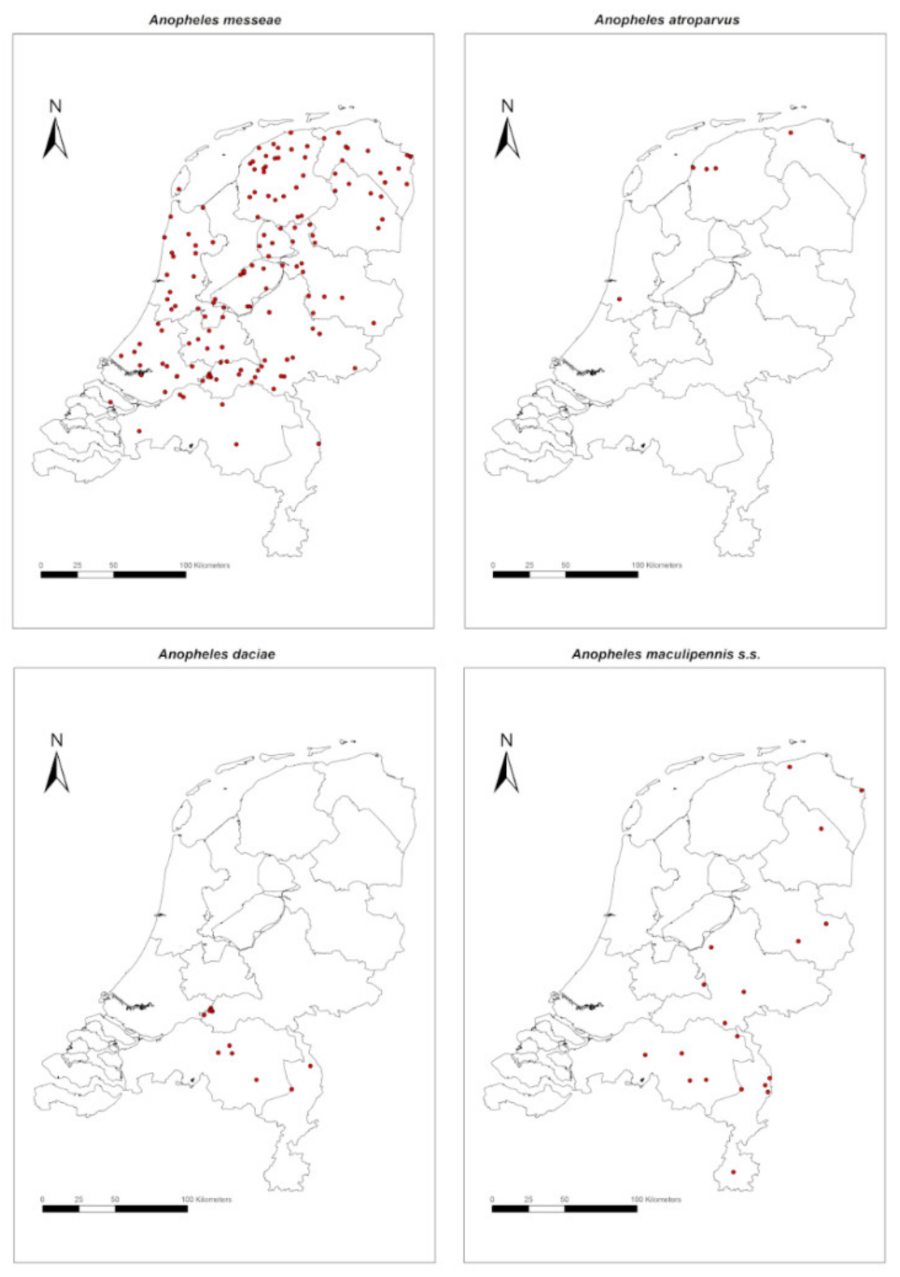Anopheles maculipennis Complex in The Netherlands: First Record of Anopheles daciae (Diptera: Culicidae)

This publication is part of the project ‘Preparing for vector-borne virus outbreaks in a changing world: a One Health Approach’ (NWA.1160.1S.210) which is (partly) financed by the Dutch Research Council (NWO).

Authors: A. Ibáñez-Justicia, Nathalie Smitz, Rody Blom, Ann Vanderheyden, Frans Jacobs, Kenny Meganck, Sophie Gombeer, Thierry Backeljau, Constantianus J. M. Koenraadt, J. S. Griep, Marc De Meyer, Arjan Stroo
Arbovirus outbreaks in communities are affected by how vectors, hosts and non-competent species interact. In this study, we investigate how ecological interactions between species and epidemiological processes influence the invasion potential of a vector-borne disease. We use an eco-epidemiological model to explore the basic reproduction number R0 for a range of interaction strengths in key processes, using West Nile virus infection to parameterize the model. We focus our analysis on intra and interspecific competition between vectors and between hosts, as well as competition with non-competent species. We show that such ecological competition has non-linear effects on R0 and can greatly impact invasion risk. The presence of multiple competing vector species results in lower values for R0 while host competition leads to the highest values of risk of disease invasion. These effects can be understood in terms of how the competitive pressures influence the vector-to-host ratio, which has a positive relationship with R0. We also show numerical examples of how vector feeding preferences become more relevant in high competition conditions between hosts. Under certain conditions, non-competent hosts, which can lead to a dilution effect for the pathogen, can have an amplification effect if they compete strongly with the competent hosts, hence facilitating pathogen invasion in the community.
1. Introduction
In the Netherlands, the last published checklist of mosquitoes (Diptera: Culicidae) included 35 indigenous species [1]. This list is not static and was recently updated with a new indigenous species, Culiseta longiareolata [2]. Four members of the Anopheles maculipennis complex (= s.l.) are reported as present in the published checklist [1], some of which are capable of carrying pathogens of medical importance, including malaria: Anopheles atroparvus van Thiel, 1927, An. messeae Falleroni, 1926, An. maculipennis sensu stricto Meigen, 1818, and An. melanoon Hackett, 1934. However, this latter species is not considered to occur in the Netherlands by [3], and An. maculipennis s.s. is considered uncommon in the country [4]. Anopheles atroparvus is reported as the only malaria vector (Plasmodium vivax and Plasmodium malariae) in the coastal areas of the Netherlands. Experimentally, An. atroparvus can also be an effective host and capable of transmitting Plasmodium ovale to humans [5]. A comparison of the anopheline species composition between 1935 and 1999 showed a prevalence shift from An. atroparvus to An. messeae in the Delta of the Rivers Rhine and Meuse, coinciding with the disappearance of indigenous malaria [6]. In a study of overwintering mosquitoes in several farms in the Netherlands, An. messeae individuals were more frequently found and An. atroparvus was less common [4]. A decline of An. atroparvus over the 20th century was recorded in multiple European countries and was assumed to be linked to major ecological changes, such as drainage practices, surface water pollution, loss of suitable resting sites for hibernation, etc. [6,7,8].
Despite their past importance as vectors of indigenous malaria and their potential role in the transmission of imported tropical malaria, leading to the reappearance of autochthonous malaria cases in Europe [9], the species composition and spatial distribution of the members of An. maculipennis s.l. in the Netherlands has been poorly studied. Individuals of An. maculipennis s.l. were found at 144 sampling sites during a nationwide inventory of indigenous mosquitoes, involving natural, rural and urban habitats [10]. However, this nationwide inventory did not include DNA-based species identifications to distinguish the members of the complex. Yet, the nuclear ribosomal internal transcribed spacer 2 (ITS2) flanked by portions of the conserved 5.8S and 28S rDNA is useful in this respect [11,12,13]. Since the members of the An. maculipennis complex are difficult to discriminate by morphological characteristics, their identification needs to be verified by ITS2 sequencing.
Anopheles daciae Linton, Nicolescu & Harbach, 2004, is a recently described species of the An. maculipennis complex that is distributed throughout continental Europe [14] and has been found over the past years in the countries bordering the Netherlands, including Germany [15,16], the United Kingdom [11], and Belgium [17]. Nevertheless, An. daciae has not yet been reported in the Netherlands. Therefore, the aim of this study was 1) to investigate the distribution of An. maculipennis s.l. members present in the Netherlands by applying ITS2 sequencing and 2) to find evidence of the presence of An. daciae in the Netherlands, where it is expected to occur, given its presence in neighboring countries.
Source: MDPI
Date: June 29th 2022